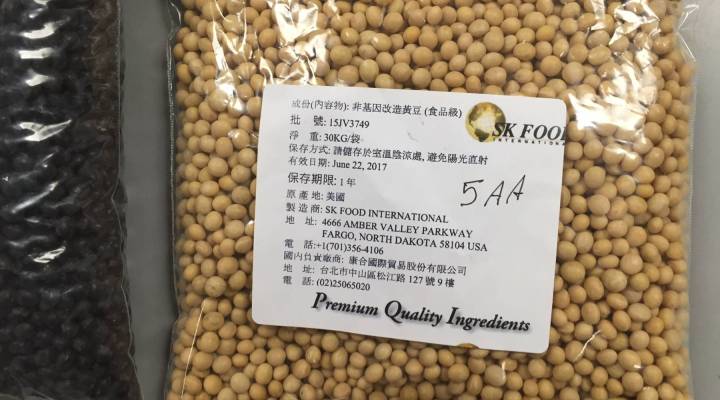
Jack and the non-GMO beanstalk

In the late 90s, many farmers went all in on biotech crops, whose genetics have been tweaked to do things like repel insects or resist herbicides. Today, about 90 percent of the corn and soybeans grown in the U.S. are genetically modified.
But as crop prices falter, and some Americans express wariness about GMOs, farmers are increasingly interested in non-biotech crops.
Jack Bruns, a farmer in Valley City, North Dakota, is among them. About 10 years ago, he decided to grow some non-biotech soybeans. His motivation was simple: “To make more money!” he said.
But they’re a lot trickier to manage. Controlling weeds is more challenging. Bruns uses plenty of synthetic chemicals (this isn’t organic agriculture), but because the soybeans have not been modified to resist the weedkillers, he has to be more careful about the timing of his applications so that he doesn’t harm his crop.
And Bruns has to handle the non-GMO beans more gingerly during harvest, storage and transport. One of the companies he supplies, Healthy Food Ingredients, markets them as food grade. So the beans can’t have any cracks, mud or grass stains.

Farmer Jack Bruns and crop specialist Joel Owen in Bruns’s non-biotech soybean field in Valley City, N.D.
“I always tell guys, ‘If what’s in the hopper is something you don’t want to put in your mouth, no one else will, either,’” said Joel Owen, a crop production specialist at SK Food International, one of the Healthy Food Ingredients brands.
None of this would matter with GMOs destined for animal feed or soybean oil.
Bruns also has to be vigilant about keeping GMOs at a safe distance. He still grows some biotech corn and soybeans, so they’re around on his farm. He has to use a hose attached to an air compressor to blast any genetically modified corn kernels or soybeans from all the nooks and crannies of his equipment and storage bins.
Other people in the supply chain might not be so careful. Bruns once bought seeds that had been cleaned at a commercial facility, and they got contaminated by biotech beans, like the kind resistant to the herbicide Roundup.
“You know what a soybean looks like? Little round BB. They go on the floor, go here and there and go everywhere,” he said. “I would say it’s impossible to get every Roundup bean in a commercial facility out.”
Healthy Food Ingredients might reject the load at its facility in Moorhead, Minnesota, if the beans test positive for genetically modified material.
“We’ve never had a GMO come through this facility,” said Jennifer Tesch, the company’s chief marketing officer.

When soybeans arrive at Healthy Food Ingredient’s facility in Moorhead, Minn., they’re ground down and mixed with water. Then workers dip test strips, that resemble pregnancy test strips, into the solution, to test for the presence of genetically modified ingredients.
If the beans pass muster, they’ll eventually get packaged up and labeled with a code that indicates the exact farmer and lot they came from.Tesch said when a farmer like Jack Bruns delivers a load of soybeans, the company’s staff will grind the beans down, mix them with water, and dip little test strips into the solution. The strips are then scanned and analyzed by computer software to reveal the quantity of genetically modified material present.
“We have a customer that makes soymilk out of our soybeans overseas,” said Tesch. “They use that same grower code on their finished retail bottle to tell the story to their customers in that market, ‘We know who this farmer is, we know where your food came from.’”
This couldn’t be more different from the trajectory of most corn and soybeans. When they’re shipped out in a rail car, their provenance ceases to matter. You would have no idea which farm they came from.
“Is it possible for 100 percent of the food market to go to this? Probably not,” said Tesch. “Is it scalable to continue to grow where multinationals can start utilizing more non-GMO ingredients? Yes, it’s possible.”
Bruns stops short of advocating for more non-biotech crops. He has no problem eating foods with genetically modified ingredients. So his interest in the matter is financial, not ideological.
But he said some farmers don’t even see the financial incentives as worth it, given all the extra work non-biotech soybeans entail.“My brother– he wouldn’t mess with this for nothing,” Bruns said. “Doesn’t matter.”
There’s a lot happening in the world. Through it all, Marketplace is here for you.
You rely on Marketplace to break down the world’s events and tell you how it affects you in a fact-based, approachable way. We rely on your financial support to keep making that possible.
Your donation today powers the independent journalism that you rely on. For just $5/month, you can help sustain Marketplace so we can keep reporting on the things that matter to you.


















